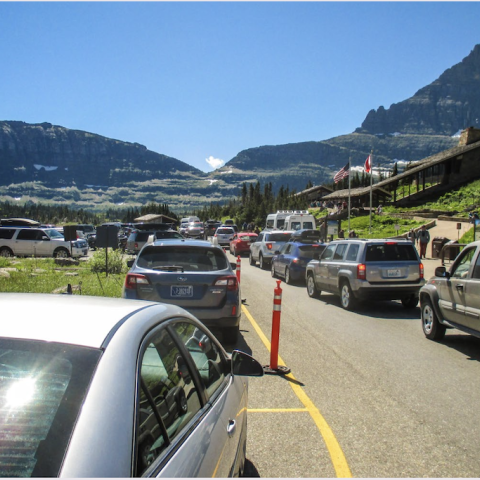Need proof of the maintenance backlog in the National Park System? Drive the Many Glacier Road in Glacier National Park in Montana. Just drive slowly so you can dodge the dips and potholes.
Park staff say the road is in poor condition due to historic and ongoing soil movement at specific locations along Sherburne Reservoir. There are six “slide” areas along the road within the park boundary, and five additional slide areas on the Blackfeet Reservation between Babb and the park boundary that make the road difficult to navigate.
Between 2017 and 2022, the park, in partnership with the Federal Highway Administration and the Blackfeet Nation, has launched an effort to evaluate and rehabilitate the road where it is possible to do so, taking into account the significant geologic and hydrologic conditions at play.
Slides occur when water saturates the soils underneath the road bed, resulting in the earth slipping towards the reservoir, causing depressions or “slumps” in the road. Some slumps can extend dozens of feet below the ground, and hundreds of feet in length.
The movement along the roadway dates back to the construction of the Sherburne Dam between 1914 and 1921. The Many Glacier Road was constructed in 1927-28 and three slides immediately formed. Over the years, attempts to fix the slump areas have resulted in significant pavement placed on the road, adding to its weight and exacerbating the problem.
The Federal Highway Administration has been monitoring specific slide areas by drilling (boring) deeply into the earth to determine how deep the groundwater is, and installing sensitive instruments to monitor movement in the soil. Over the years, these instruments have been damaged and lost in less than one season due to how much the ground moves. Results from nine vertical borings between the park boundary and park entrance station revealed that one of the deepest slides had slipped in excess of 90 vertical feet since the road was constructed in the late 1920s.
In 2017, Federal Highway Administration contracted to have more than 70 horizontal drains installed into the slope at the worst slump along the road, approximately 1.5 miles west of the park boundary. These drains were placed in the fall of 2017 just above the normal high water mark of the reservoir and were intended to remove excess groundwater with the hope that continued sliding would be stopped.
Throughout 2018 and 2019, the park and Federal Highway Administration will monitor their effectiveness. The results to date are very promising, indicating that the drains may be a viable solution to halt the sliding at the other slump areas. Various solutions have been studied and proposed for the past six decades and this is the first time a cost-effective solution has shown promise.
This year, the park is also using a "durapatcher" to fill some potholes in non-slump areas. The $77,500 machine was a donation from the Glacier National Park Conservancy, and is being used on different roads throughout the park. It's expected that it will also be used on the alpine section of the Going-to-the-Sun Road, reducing construction delays that would otherwise be needed for larger paving initiatives.
In the fall of 2019, the park will mill up asphalt from the park boundary to just east of the entrance station, creating a gravel surface. This will allow the road to be graded, which is not possible right now given the amount of asphalt present. Adding additional asphalt to the road surface in slump areas is no longer an option, as it adds to the overall weight of the road and contributes to further slumping.
In 2019 through 2020, road and parking area improvements within the park will be undertaken with funds from the Federal Lands Transportation Program. This road work will not address the slump areas, which will continue to be graded.
Concurrent with that work, the Federal Highway Administration in partnership with the Blackfeet Nation will rehabilitate the 4.8 mile road segment from Babb, Montana to the park boundary, funded under the Federal Lands Access Program.
In the early 2020s, depending on the success of the horizontal drains, additional drain systems would be installed. Ultimately, additional road sections would be rehabilitated in the slump areas if the drains prove effective.




 Support Essential Coverage of Essential Places
Support Essential Coverage of Essential Places







Add comment